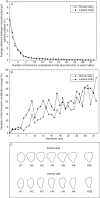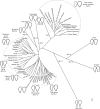Evolution and history of grapevine (Vitis vinifera) under domestication: new morphometric perspectives to understand seed domestication syndrome and reveal origins of ancient European cultivars
- PMID: 20034966
- PMCID: PMC2826248
- DOI: 10.1093/aob/mcp298
Evolution and history of grapevine (Vitis vinifera) under domestication: new morphometric perspectives to understand seed domestication syndrome and reveal origins of ancient European cultivars
Abstract
Background and aims: In spite of the abundance of archaeological, bio-archaeological, historical and genetic data, the origins, historical biogeography, identity of ancient grapevine cultivars and mechanisms of domestication are still largely unknown. Here, analysis of variation in seed morphology aims to provide accurate criteria for the discrimination between wild grapes and modern cultivars and to understand changes in functional traits in relation to the domestication process. This approach is also used to quantify the phenotypic diversity in the wild and cultivated compartments and to provide a starting point for comparing well-preserved archaeological material, in order to elucidate the history of grapevine varieties.
Methods: Geometrical analysis (elliptic Fourier transform method) was applied to grapevine seed outlines from modern wild individuals, cultivars and well-preserved archaeological material from southern France, dating back to the first to second centuries.
Key results and conclusions: Significant relationships between seed shape and taxonomic status, geographical origin (country or region) of accessions and parentage of varieties are highlighted, as previously noted based on genetic approaches. The combination of the analysis of modern reference material and well-preserved archaeological seeds provides original data about the history of ancient cultivated forms, some of them morphologically close to the current 'Clairette' and 'Mondeuse blanche' cultivars. Archaeobiological records seem to confirm the complexity of human contact, exchanges and migrations which spread grapevine cultivation in Europe and in Mediterranean areas, and argue in favour of the existence of local domestication in the Languedoc (southern France) region during Antiquity.
Figures






Similar articles
-
Genetic changes in the genus Vitis and the domestication of vine.Front Plant Sci. 2023 Feb 28;13:1019311. doi: 10.3389/fpls.2022.1019311. eCollection 2022. Front Plant Sci. 2023. PMID: 36926258 Free PMC article. Review.
-
Eco-evo-devo implications and archaeobiological perspectives of trait covariance in fruits of wild and domesticated grapevines.PLoS One. 2020 Nov 6;15(11):e0239863. doi: 10.1371/journal.pone.0239863. eCollection 2020. PLoS One. 2020. PMID: 33156832 Free PMC article.
-
Seed morphometrics unravels the evolutionary history of grapevine in France.Sci Rep. 2024 Sep 27;14(1):22207. doi: 10.1038/s41598-024-72692-6. Sci Rep. 2024. PMID: 39333563 Free PMC article.
-
Genetic diversity analysis of cultivated and wild grapevine (Vitis vinifera L.) accessions around the Mediterranean basin and Central Asia.BMC Plant Biol. 2018 Jun 27;18(1):137. doi: 10.1186/s12870-018-1351-0. BMC Plant Biol. 2018. PMID: 29945553 Free PMC article.
-
Back to the Origins: Background and Perspectives of Grapevine Domestication.Int J Mol Sci. 2021 Apr 26;22(9):4518. doi: 10.3390/ijms22094518. Int J Mol Sci. 2021. PMID: 33926017 Free PMC article. Review.
Cited by
-
Bioarchaeological insights into the process of domestication of grapevine (Vitis vinifera L.) during Roman times in Southern France.PLoS One. 2013 May 15;8(5):e63195. doi: 10.1371/journal.pone.0063195. Print 2013. PLoS One. 2013. PMID: 23690998 Free PMC article.
-
Discovering Plum, Watermelon and Grape Cultivars Founded in a Middle Age Site of Sassari (Sardinia, Italy) through a Computer Image Analysis Approach.Plants (Basel). 2022 Apr 16;11(8):1089. doi: 10.3390/plants11081089. Plants (Basel). 2022. PMID: 35448816 Free PMC article.
-
The Domestication Syndrome in Phoenix dactylifera Seeds: Toward the Identification of Wild Date Palm Populations.PLoS One. 2016 Mar 24;11(3):e0152394. doi: 10.1371/journal.pone.0152394. eCollection 2016. PLoS One. 2016. PMID: 27010707 Free PMC article.
-
Genetic changes in the genus Vitis and the domestication of vine.Front Plant Sci. 2023 Feb 28;13:1019311. doi: 10.3389/fpls.2022.1019311. eCollection 2022. Front Plant Sci. 2023. PMID: 36926258 Free PMC article. Review.
-
Alternative Modes of Introgression-Mediated Selection Shaped Crop Adaptation to Novel Climates.Genome Biol Evol. 2022 Aug 3;14(8):evac107. doi: 10.1093/gbe/evac107. Genome Biol Evol. 2022. PMID: 35859297 Free PMC article.
References
-
- André J. Contribution au vocabulaire de la viticulture: les noms de cépages. Revue d'Etudes Latines. 1952;30:126–156.
-
- Anzani R, Failla O, Scienza A, Campostrani F. Wild grapevine (Vitis vinifera var silvestris) in Italy: diffusion, characteristics and germplasm preservation, 1989 report. Proceedings of the 5th International Symposium on Grape Breeding. Vitis. 1990:97–113. Bundesforschungsanstalt fur Rebenzuchtung, Siebeldingen, Germany, ed. special issue.
-
- Aradhya MK, Dangl GS, Prins BH, et al. Genetic structure and differentiation in cultivated grape, Vitis vinifera L. Genetics Research. 2003;81:179–192. - PubMed
-
- Arnold C, Gillet F, Gobat JM. Situation de la vigne sauvage Vitis vinifera subsp. silvestris en Europe. Vitis. 1998;37:159–170.
-
- Arnold C, Schnitzler A, Douard A, Peter R, Gillet F. Is there a future for wild grapevine (Vitis vinifera subsp. silvestris) in the Rhine Valley? Biodiversity and Conservation. 2005;14:1507–1523.

